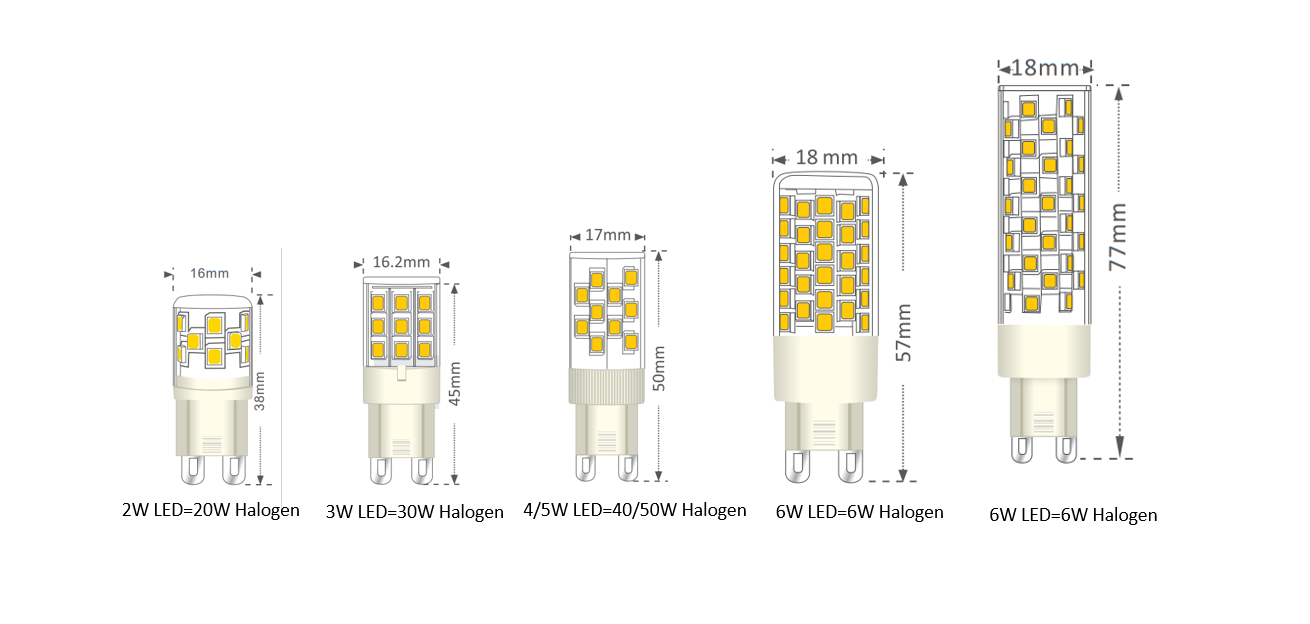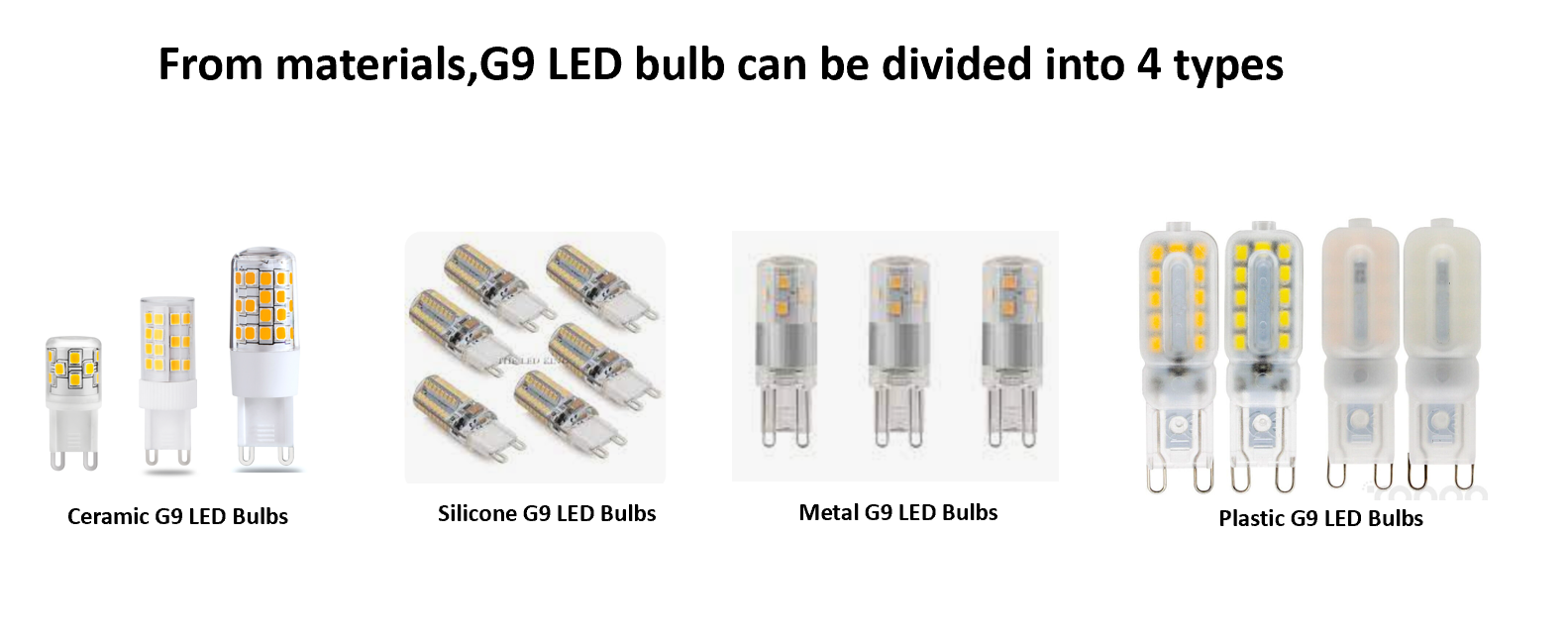G9 LED Bulbs: Classification and Essential Export Certifications for Europe and America
Author:Admin Publish time: July 24, 2023 Origin: Site
What is Halogen G9 Bulb
The term "G9" refers to the type of base or socket used to connect the bulb to the fixture. G9 bulbs have a two-pin bi-pin base, which means they have two pins that protrude from the base and fit into a socket with corresponding holes.
The "G" in G9 stands for "glass," indicating that the base is made of glass. The number "9" refers to the distance between the two pins in millimeters. Therefore, a G9 bulb has two pins spaced 9mm apart.
Halogen G9 bulbs with different wattages (10W, 20W, 30W, 40W, 50W,60W,75W), and they all share a same size (Φ14*43mm).
.png)
Where is G9 Bulb Commonly used?
The G9 bulb is commonly used in smaller light fixtures, such as certain types of chandeliers, wall sconces, and pendant lights. It is a popular choice for compact and space-saving lighting solutions due to its small size and easy installation
Chandeliers: G9 bulbs are frequently used in chandeliers, where their small size allows for multiple bulbs to be arranged elegantly, providing a stylish and bright lighting solution.
Wall Sconces: G9 bulbs are suitable for wall sconces, adding a warm and inviting glow to hallways, staircases, and accent walls.
Pendant Lights: G9 bulbs are commonly found in pendant light fixtures, creating a focal point and illuminating dining areas or kitchen islands.
Desk Lamps: G9 bulbs are used in some desk lamps, providing task lighting for reading, studying, or working.
Bathroom Fixtures: G9 bulbs are often employed in bathroom fixtures, such as vanity lights and mirror lights, offering bright and efficient illumination.
Cabinet Lights: G9 bulbs are utilized in cabinet lights, illuminating shelves and display cabinets with a focused and energy-efficient light source.
Ceiling Lights: G9 bulbs can be found in various ceiling light fixtures, including flush mount or semi-flush mount lights, providing ambient lighting in living rooms, bedrooms, and other spaces.
Outdoor Lights: G9 bulbs designed for outdoor use can be used in certain landscape lights or outdoor wall fixtures, enhancing the visibility and security of the exterior area.
Retail Displays: G9 bulbs are sometimes used in retail settings to highlight and accentuate product displays, adding a touch of brilliance to merchandise.
Art and Gallery Lighting: G9 bulbs are suitable for lighting art pieces or gallery exhibits, as their small size and good color rendering properties showcase artwork effectively.
Why Our different watt G9 LED bulb has different size?
As professional manufacturer, we know G9 LED bulbs are intended to replace halogen G9 Bulb, designed to have small dimensions, high lumen output, and frequently used in enclosed fixtures in humid environments, it is crucial to subject them to more rigorous testing to ensure their performance and safety in such conditions. Below are Saco lighting’s series different Watt G9 LED bulb with different size accordingly.

To handle the increased heat output, manufacturers may design G9 LED bulbs with larger heat sinks or other cooling mechanisms. Heat sinks help dissipate the heat generated by the LED chip, preventing overheating and ensuring the bulb operates at an optimal temperature,
By providing adequate space for improved heat dissipation, larger G9 LED bulbs can maintain their efficiency and reliability, ensuring consistent performance and longer life. This relationship between wattage, size, and heat management is an essential consideration in the design and manufacturing of G9 LED bulbs.
How many types G9 LED bulbs in current market ?

Ceramic G9 LED Bulbs:
Advantages: Ceramic-based G9 LED bulbs have excellent thermal conductivity, allowing for efficient heat dissipation. They can handle higher wattages and are more durable in high-temperature environments. Ceramic materials also provide better insulation and electrical safety.
Disadvantages: Ceramic G9 LED bulbs tend to be more expensive compared to other types due to the cost of the material and manufacturing processes.
Plastic G9 LED Bulbs:
Advantages: Plastic-based G9 LED bulbs are generally more affordable and lightweight. They can be easily molded into different shapes, making them suitable for various designs and styles.
Disadvantages: Plastic has lower thermal conductivity compared to ceramic, which may result in slightly less efficient heat dissipation. As a result, plastic G9 LED bulbs might be limited to lower wattages to manage heat.
Metal G9 LED Bulbs:
Advantages: Metal-based G9 LED bulbs offer good thermal conductivity, allowing for effective heat dissipation. They are durable and have a sturdy construction.
Disadvantages: Metal G9 LED bulbs might be heavier and may not provide as much flexibility in design compared to ceramic or plastic variants.
Silicone G9 LED Bulbs
Advantages: Silicone-based G9 LED bulbs offer excellent heat resistance and good thermal conductivity, allowing for effective heat dissipation. They are flexible and can withstand high temperatures without deforming or cracking. Silicone materials provide electrical insulation and are resistant to moisture and dust, making them suitable for various environments.
Disadvantages: Silicone G9 LED bulbs may have a slightly higher cost compared to plastic variants. However, their superior thermal properties and durability justify the investment in certain applications.
Each type of G9 LED bulb has its unique advantages and disadvantages. The choice of material often depends on factors such as budget, desired performance, and the specific application. Ceramic G9 LED bulbs are typically preferred for high-wattage and industrial applications where efficient heat dissipation is crucial. Plastic G9 LED bulbs are more commonly used in residential settings, offering cost-effective solutions with a wide range of design options. Metal G9 LED bulbs strike a balance between durability and thermal management and are often used in various lighting scenarios.
Based on the current market trends and shipment volumes, Ceramic G9 LED bulbs continue to be the most popular and widely produced type due to Efficient Heat Dissipation, High Wattage Handling, Durability and Reliability, Safety and Electrical Insulation
Essential Testing for G9 LED Bulbs Used in Enclosed Environments.
Heat Dissipation Testing: Since enclosed environments can trap heat, it's crucial to test the G9 LED bulbs' heat dissipation capabilities. Ensure that the bulbs can effectively dissipate heat and maintain safe operating temperatures within the enclosed space.
Temperature Testing: Evaluate the G9 LED bulbs' performance under elevated temperatures to ensure they can operate reliably within the enclosed environment.
Ingress Protection (IP) Rating Testing: Assess the bulbs' ability to resist the ingress of dust and moisture. Enclosed environments can be prone to humidity, and the IP rating helps determine the level of protection against these elements.
Endurance and Reliability Testing: Subject the G9 LED bulbs to endurance testing in conditions that simulate continuous operation in enclosed spaces. This helps assess their long-term reliability and performance.
Electrical Safety Testing: Conduct tests to assess electrical safety, including insulation resistance, dielectric strength, and grounding, to ensure the bulbs are safe for use in enclosed environments.
Photobiological Safety Testing: Evaluate the potential risks of LED light exposure to human eyes, especially in confined spaces, to ensure the bulbs are safe for use.
Environmental Testing: Test the bulbs for resistance to environmental factors like humidity, vibration, and temperature variations commonly found in enclosed environments.
EMC (Electromagnetic Compatibility) Testing: Ensure the bulbs do not emit electromagnetic interference or are susceptible to external interference when used in sealed environments.
Compatibility Testing: Verify that the G9 LED bulbs are compatible with various types of enclosed fixtures and can fit securely and function properly within these fixtures.
By conducting these tests, manufacturers can ensure that their G9 LED bulbs are designed and tested for safe and reliable performance in enclosed or sealed environments. This helps provide customers with confidence in using these bulbs for applications where proper heat management and environmental resilience are essential.
Basic certification requirements for G9 LED bulbs when export to the European market
CE Marking: The CE marking is a mandatory certification for products sold in the European Economic Area (EEA). It indicates that the G9 LED bulbs meet the essential health, safety, and environmental requirements set out in European Directives.
anti-surge level testing: they may need to undergo surge testing to ensure their reliability and safety under transient voltage conditions. The surge testing evaluates how well the product can handle sudden voltage spikes, which can occur due to lightning strikes, power surges, or other electrical disturbances in the electrical grid
ERP Certification: Energy-related Products (ERP) certification is required for energy-efficient products in Europe. It ensures that the G9 LED bulbs comply with energy efficiency regulations and contribute to energy-saving efforts, like Pst LM ≤ 1,0 at full-load, SVM≤ 0.1.at full load.
Photometric Testing: Measure and evaluate the photometric properties of the G9 LED bulbs, including their light distribution and luminous efficacy.
EMC (Electromagnetic Compatibility) Testing: Test the bulbs for electromagnetic emission and immunity to avoid interference with other electronic devices and prevent susceptibility to electromagnetic interference.
RoHS (REACH) Compliance Testing: Verify that the G9 LED bulbs comply with the RoHS directive, restricting the use of hazardous substances in electrical and electronic equipment.
Basic certification requirements for G9 LED bulbs when export to the European market
FCC Part 15 Compliance: The Federal Communications Commission (FCC) regulates electronic devices' electromagnetic interference. G9 LED bulbs must comply with FCC Part 15 rules, ensuring that they do not cause harmful interference with other electronic devices.
UL Listing: Underwriters Laboratories (UL) is a recognized testing and certification organization in the USA. Obtaining UL listing ensures that the G9 LED bulbs meet safety and performance standards, giving consumers confidence in the product's quality.
Energy Star Certification (optional): Energy Star certification is not mandatory, but it indicates that the G9 LED bulbs meet specific energy efficiency requirements set by the U.S. Environmental Protection Agency (EPA). This certification can be valuable for marketing and indicates the product's energy-saving attributes.
ETL (Electrical Testing Laboratories) is another recognized testing and certification organization in the USA. Like UL, ETL provides safety testing and certification services for various products, including LED bulbs. Obtaining ETL certification ensures that the G9 LED bulbs meet the necessary safety and performance standards required for the US market.
JA8 (Joint Appendix 8): JA8 is a set of technical requirements established by the California Energy Commission (CEC) for LED light bulbs' performance, particularly for residential lighting. Compliance with JA8 ensures that the G9 LED bulbs meet specific energy efficiency, color rendering, and flicker requirements.
Title 20: Title 20 is a California Energy Commission regulation that sets energy efficiency standards for a variety of appliances and lighting products, including LED bulbs. LED bulbs sold in California must meet the Title 20 requirements to ensure they are energy-efficient.
Title 24: Title 24 is another California Energy Commission regulation that sets building energy efficiency standards. Lighting products, including LED bulbs, used in new construction or renovation projects in California must meet Title 24 standards to contribute to overall energy efficiency goals
As a professional manufacturer of G9 LED bulbs, we welcome any inquiries or questions you may have. Our expertise lies in producing high-quality LED bulbs, and we take pride in offering customization services to meet your specific requirements.
Whether you need assistance with product specifications, technical details, bulk orders, or custom designs, feel free to contact us anytime. Our dedicated team is here to provide you with reliable solutions and ensure your satisfaction.
